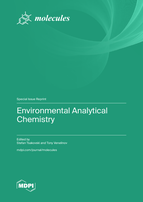Environmental Analytical Chemistry
A special issue of Molecules (ISSN 1420-3049). This special issue belongs to the section "Analytical Chemistry".
Deadline for manuscript submissions: closed (30 May 2023) | Viewed by 26352
Special Issue Editors
Interests: chemometrics; environmental analytical chemistry; intelligent data analysis
Special Issues, Collections and Topics in MDPI journals
Interests: analytical chemistry of water; water quality; laboratory accreditation
Special Issues, Collections and Topics in MDPI journals
Special Issue Information
Dear Colleagues,
The domain of environmental analytical chemistry incudes all analytical aspects of studies related to the environmental problems and their management. The analysis of organic, inorganic and radioactive pollutants in air, water, soil and biota is quite a challenging task at the time of large social development and climate changes. In addition, the development of new analytical methods or improvement of existing ones for the monitoring of pollutants is of a paramount importance for achieving such goals. The other important task is implementation of appropriate methods and procedures for pollution risk assessment revealing sources, pathways of exposure, trends and spatial distribution of analyzed pollutants.
For these reasons, we would like to invite you to contribute to this Special Issue of Molecules titled “Environmental Analytical Chemistry”. Your valuable unpublished research can find a worldwide audience among readers of Molecules.
Prof. Dr. Stefan Leonidov Tsakovski
Dr. Tony Venelinov
Guest Editors
Manuscript Submission Information
Manuscripts should be submitted online at www.mdpi.com by registering and logging in to this website. Once you are registered, click here to go to the submission form. Manuscripts can be submitted until the deadline. All submissions that pass pre-check are peer-reviewed. Accepted papers will be published continuously in the journal (as soon as accepted) and will be listed together on the special issue website. Research articles, review articles as well as short communications are invited. For planned papers, a title and short abstract (about 100 words) can be sent to the Editorial Office for announcement on this website.
Submitted manuscripts should not have been published previously, nor be under consideration for publication elsewhere (except conference proceedings papers). All manuscripts are thoroughly refereed through a single-blind peer-review process. A guide for authors and other relevant information for submission of manuscripts is available on the Instructions for Authors page. Molecules is an international peer-reviewed open access semimonthly journal published by MDPI.
Please visit the Instructions for Authors page before submitting a manuscript. The Article Processing Charge (APC) for publication in this open access journal is 2700 CHF (Swiss Francs). Submitted papers should be well formatted and use good English. Authors may use MDPI's English editing service prior to publication or during author revisions.
Keywords
- Method development for analysis of environmental compartments
- Method validation
- Environmental monitoring
- Water, air and soil pollution
- Ecotoxicology
- Pollution risk assessment








